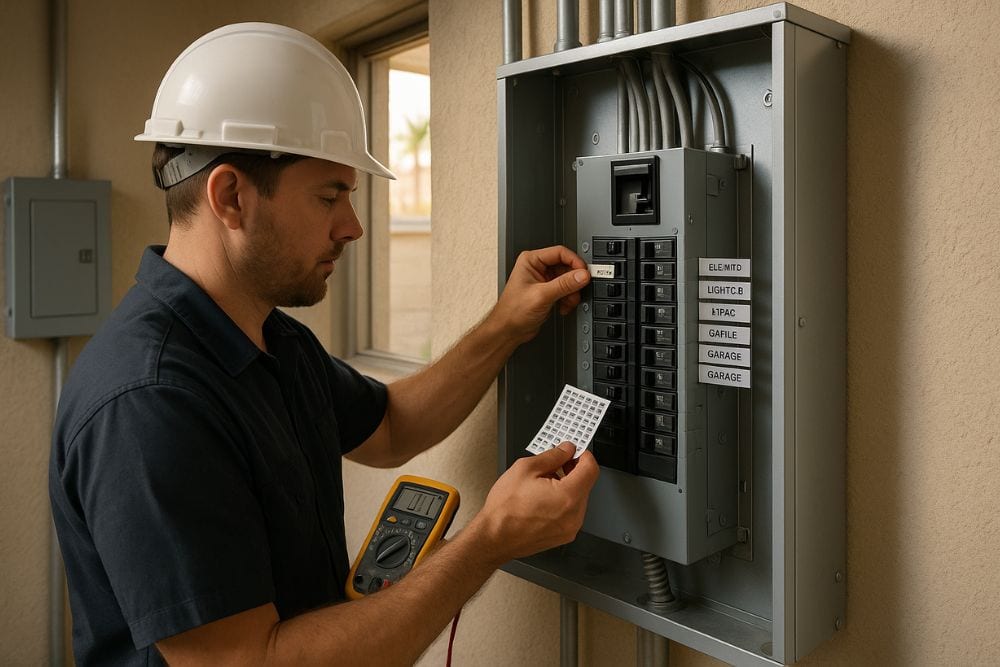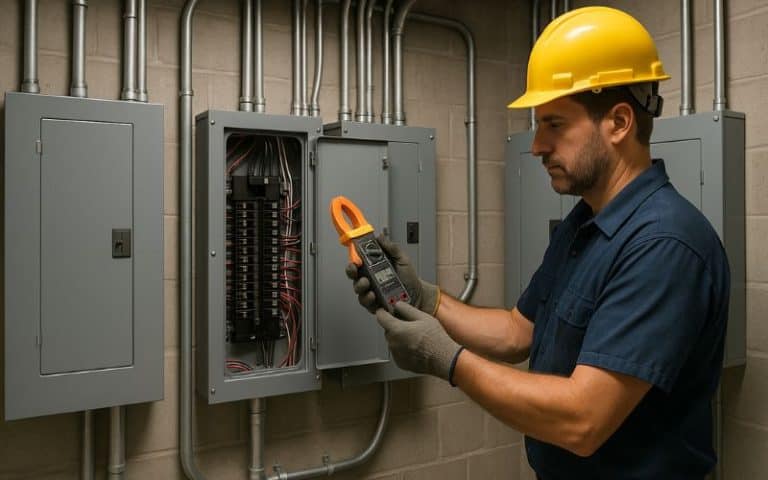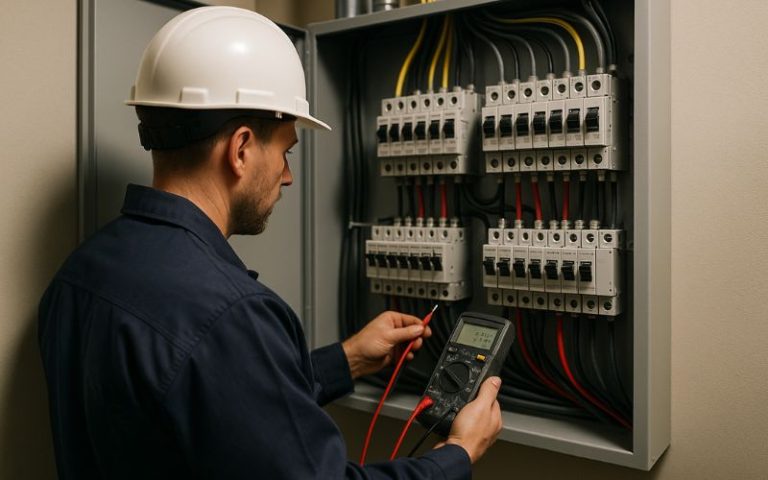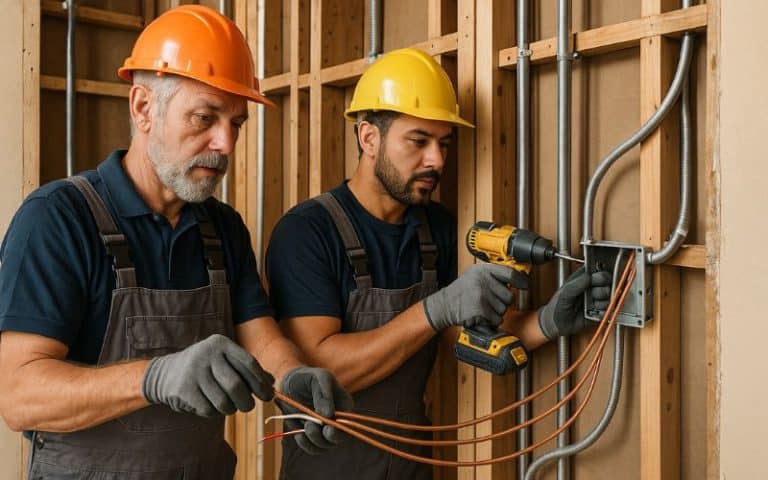
Why Proper Circuit Labeling Matters for Los Angeles Multi-Unit Properties
One Small Label Can Prevent a Big Problem
It starts with a simple service call, a tenant reports that half the lights in their apartment have gone out. The property manager sends maintenance to reset the breaker, but when they open the panel, nothing is labeled clearly. After guessing and testing a few switches, the wrong circuit gets shut off, cutting power to another unit. Minutes later, a refrigerator full of food warms up, and frustration spreads across the building.
Scenes like this are surprisingly common in Los Angeles’s multi-unit properties. Older apartment buildings, mixed-use spaces, and commercial complexes often rely on electrical systems that have been modified, expanded, or “patched together” over the years. Without accurate circuit labeling, even experienced electricians must waste valuable time tracing wires to find the right connection.
Proper labeling isn’t just about convenience, it’s a crucial element of electrical safety and code compliance. Clear, accurate panel labels prevent power loss, reduce fire risks, speed up repairs, and keep your property in good standing with the Los Angeles Department of Building and Safety (LADBS).
At RG Electric, we’ve seen firsthand how well-labeled panels save property managers time, money, and liability. This guide explains why proper circuit labeling matters, what the law requires, and how it protects your tenants and your bottom line.
Why Circuit Labeling Is a Big Deal for Multi-Unit Buildings in Los Angeles
Los Angeles properties are some of the most complex electrical environments in the country. Between tenant improvements, remodels, and growing electrical demand, panels can quickly become confusing, especially in older multi-unit buildings where systems were never standardized.
Complex Loads Create Confusing Panels
In a typical LA apartment building or mixed-use complex, circuits may feed everything from shared laundry rooms and hallway lights to individual kitchen outlets. Without proper labeling, one breaker might control a tenant’s refrigerator and another tenant’s bathroom fan. In emergencies, that confusion can delay power restoration and increase frustration for everyone involved.
Clear circuit labeling allows property managers and electricians to isolate issues quickly and safely. It’s the difference between restoring power in ten minutes and spending hours testing circuits with tenants waiting.
Code Compliance and Safety Requirements
The National Electrical Code (NEC) Section 408.4(A) mandates that all circuit directories be legible, accurate, and permanent. That means handwritten or fading labels are not enough. Every circuit must clearly describe the area or equipment it controls, such as “Unit 2A Kitchen” or “Lobby Lighting,” and must match the actual electrical layout.
The LADBS enforces these requirements across Los Angeles. During inspections or renovations, mislabeled or missing circuit directories can lead to correction notices, delayed approvals, or even failed inspections. Proper labeling isn’t optional, it’s a compliance necessity.
Efficiency During Repairs and Emergencies
When the power goes out or an outlet stops working, time is critical. Accurate labeling helps electricians locate the correct circuit immediately, preventing unnecessary shutdowns and reducing tenant inconvenience. In commercial buildings, this efficiency keeps businesses operational and minimizes lost revenue during repairs.
Insurance and Liability Protection
From a legal perspective, circuit labeling is also a form of risk management. If an electrical incident occurs, such as an arc fault or fire, and the investigation reveals unlabeled or mislabeled panels, insurance claims may be delayed or denied. Property owners and managers are expected to maintain their electrical systems to current safety standards.
Keeping circuit labels accurate and up to date demonstrates due diligence and can protect you from liability if something goes wrong.
The Legal, Safety, and Financial Risks of Poor Labeling
Improper or missing circuit labeling might seem like a small oversight, but in multi-unit Los Angeles buildings, it can lead to serious safety hazards, code violations, and costly downtime. For property managers and owners, unlabeled or mislabeled panels can turn a routine maintenance task into a fire risk, an insurance dispute, or a failed LADBS inspection.
Safety Risks: When Guesswork Becomes Dangerous
When electricians or maintenance staff can’t identify the right circuit, they’re forced to test breakers by trial and error. That approach might seem harmless, but it carries real danger. Accidentally shutting off the wrong circuit can disrupt safety systems, disable lighting in occupied areas, or cause power surges that damage connected equipment.
In older properties, shared neutrals and poorly grounded circuits can compound these risks. Turning off a mislabeled breaker might leave part of the circuit energized, putting workers at risk of electrical shock. These situations are entirely preventable with proper circuit mapping and permanent labeling.
Clear labeling ensures that anyone accessing your electrical panels, whether a licensed electrician, maintenance tech, or LADBS inspector, knows exactly which circuit controls which area. It’s not just about organization; it’s about keeping people safe.
Legal and Code Compliance Obligations
The National Electrical Code (NEC) 408.4(A) is clear: every circuit directory must be accurate, complete, and permanently affixed. Handwritten notes, masking tape, or outdated panel cards don’t meet the standard. For commercial or multi-unit residential properties, failure to comply can trigger code violations and correction notices during inspection.
Los Angeles enforces these rules strictly through the Los Angeles Department of Building and Safety (LADBS). Any property undergoing electrical upgrades, inspections, or remodels must demonstrate compliance. Inspectors routinely require accurate labeling before signing off on permits or final approvals.
Inconsistent or missing labeling can also delay property sales, refinancing, or insurance renewals, as most due diligence inspections now include electrical safety documentation.
(See LADBS Electrical Code and NFPA 70: National Electrical Code for official standards.)
Financial Risks and Hidden Costs
The financial cost of poor labeling often surfaces at the worst possible moment — during an outage or emergency repair. Electricians may spend hours tracing circuits manually, driving up labor costs and prolonging downtime. For multi-unit buildings, that means frustrated tenants, lost revenue, and higher maintenance bills.
Even simple maintenance tasks, like replacing an outlet or upgrading lighting, take longer when technicians must identify which breaker controls which space. That inefficiency adds up quickly across multiple properties.
For larger commercial clients, unlabeled panels can also complicate compliance reporting under the Existing Building Energy and Water Efficiency (EBEWE) program. Documentation of electrical systems and controls becomes harder to complete, leading to potential fines or compliance delays.
Insurance and Liability Exposure
From an insurance perspective, circuit labeling demonstrates that a property owner has taken reasonable steps to maintain a safe electrical system. After an electrical fire, short circuit, or tenant injury, investigators look closely at maintenance records and system condition. A clearly labeled panel supports your claim and helps establish compliance with recognized safety standards.
Conversely, if labeling is missing or inaccurate, insurers may argue that the property owner neglected preventive maintenance, potentially delaying or reducing payout. For property managers overseeing multiple buildings, this can introduce significant liability risk.
Proper labeling also protects your vendors and maintenance teams. When electricians can quickly identify circuits, they can isolate faults safely and reduce the chance of accidental power interruptions or equipment damage.
Reputation and Tenant Trust
Tenants notice when a property is well maintained. A building where the lights work reliably and power issues are resolved quickly signals professionalism and safety. In contrast, repeated outages or delayed repairs, often caused by unlabeled panels, can frustrate tenants and damage relationships.
For property management companies in Los Angeles’s competitive rental market, small operational improvements like labeling contribute to long-term tenant retention. It’s one of those behind-the-scenes investments that pays off quietly but powerfully over time.
How Proper Labeling Improves Maintenance and Tenant Satisfaction
Proper circuit labeling might not seem glamorous, but for Los Angeles property managers, it’s one of the most powerful tools for keeping buildings efficient, compliant, and tenant-friendly. When panels are accurately marked, repairs happen faster, outages are shorter, and everyone, from electricians to tenants, feels more confident in the property’s safety.
Faster, Smarter Maintenance
When panels are labeled clearly, electricians can go straight to the right circuit instead of spending valuable time tracing wires and testing breakers. That efficiency means less disruption for tenants and lower labor costs for property owners. In large multi-unit buildings where access to units is limited, proper labeling can save hours on each service call.
For example, when an outlet stops working in one apartment, an electrician should be able to identify and isolate the correct breaker immediately, not shut down power to multiple units in the process. Accurate labeling eliminates guesswork, reduces noise complaints, and shortens service windows, especially during after-hours maintenance.
Reduced Downtime and Tenant Disruption
Every minute without power impacts tenants. Whether it’s residents who lose air conditioning during the summer or businesses whose computers shut down unexpectedly, downtime affects satisfaction and trust. When circuits are labeled, outages are restored more quickly, and unnecessary shutdowns are avoided.
This matters even more for commercial spaces with mixed loads, lighting, refrigeration, or office equipment that runs continuously. Quick restoration times help preserve tenant productivity and prevent revenue loss.
Simplified Troubleshooting and Preventive Maintenance
Labeling is also invaluable for long-term maintenance. When property managers schedule seasonal electrical inspections, clearly marked panels help electricians verify load distribution, detect potential overloads, and identify circuits that draw excessive current.
If a property uses a mix of residential and commercial meters or sub-panels, labeling makes it easier to track which tenants are connected to which systems. This improves accuracy in billing, energy audits, and planning future upgrades.
Clear, professional labeling is part of a well-documented electrical management system, a standard practice in buildings that prioritize efficiency and accountability.
Improved Safety for Tenants and Maintenance Staff
In emergencies, proper labeling can prevent injuries and damage. If a breaker must be shut off to address a wiring issue or water leak, knowing exactly which circuit controls which area keeps everyone safe. In contrast, guessing can disable critical systems like hallway lighting, elevators, or exit signs.
Property managers are also responsible for protecting maintenance workers and contractors who service panels. Accurate labeling helps them isolate live circuits safely and prevents accidental shocks or equipment damage. It’s a key component of both LADBS and OSHA safety standards for multi-tenant buildings.
Professional Appearance and Tenant Confidence
Electrical panels might be hidden from public view, but their condition speaks volumes about how a property is maintained. When tenants see a clean, organized, and well-labeled panel, it communicates professionalism and attention to detail. It tells them that the building’s systems are modern, compliant, and safe, which builds trust and tenant satisfaction.
Even simple upgrades, like printed labels instead of handwritten tape, show that a property is managed proactively. For property management companies competing for high-value tenants, these small operational details create a strong impression.
Easier Coordination Between Teams
Large properties often have multiple electricians, maintenance personnel, or contractors servicing different systems. Without clear labeling, coordination becomes difficult and mistakes happen. A standardized labeling system ensures that every professional who opens a panel knows what each breaker controls — no confusion, no duplication, and no dangerous errors.
RG Electric helps property managers create consistent labeling systems that match every sub-panel across a property. Each breaker and circuit is mapped, documented, and clearly marked, allowing seamless collaboration between service teams and ensuring consistency from one visit to the next.
RG Electric’s Labeling and Panel Management Solutions
At RG Electric, we understand that property managers in Los Angeles have enough to juggle without worrying about mislabeled panels, confusing sub-panels, or failed inspections. That’s why we offer comprehensive circuit labeling and panel management services designed specifically for multi-unit buildings, apartment complexes, and commercial properties.
Proper labeling isn’t just about compliance, it’s about giving you a system that works. Our electricians combine technical precision with local code expertise to ensure your property’s panels are clearly, accurately, and permanently marked for safety and reliability.
Comprehensive Labeling Audits
Every project begins with a complete panel and circuit audit. We trace each circuit from its breaker to the outlets, lighting, and equipment it controls, confirming accuracy and documenting every connection.
Our team then creates a clean, permanent directory using professional-grade labels that meet NEC 408.4(A) and LADBS standards. Whether your building has three panels or thirty, we make sure each one is organized and easy to understand.
If we discover outdated or overloaded panels during this process, we’ll document the issue and recommend solutions through our Electrical Panel Services in Los Angeles page. This ensures your entire system, not just the labeling, remains safe and code compliant.
Durable and Professional Labeling Systems
We use printed, tamper-resistant labels rated for heat, moisture, and age. Unlike handwritten stickers that fade over time, these labels stay legible and professional for years. Each breaker is marked clearly, and every panel includes a printed circuit directory that’s easy to update when tenants change or renovations occur.
For high-traffic maintenance rooms, we can also install clear protective covers over directories to prevent smudging or accidental damage.
Digital Circuit Mapping for Large Properties
For properties with multiple panels, RG Electric offers digital circuit mapping. This modern approach creates a visual record of every breaker, circuit, and sub-panel in your system. It’s ideal for property management teams that want quick reference from a mobile device or tablet during service calls or inspections.
Digital circuit maps are especially useful in large apartment complexes, retail plazas, or multi-building campuses. They allow maintenance teams to locate specific breakers instantly, even if panels are in different parts of the property.
Integration With Broader Electrical Services
Circuit labeling is often the first step toward better system management. Once panels are organized, many property managers schedule upgrades or repairs to further improve safety and efficiency. RG Electric can handle these seamlessly through our related services:
- Electrical Repairs Services in Los Angeles for damaged or faulty breakers, wiring, or outlets.
- Commercial Electrical Services in Los Angeles for ongoing property maintenance and multi-tenant systems.
- Wiring Services in Los Angeles for outdated aluminum or cloth wiring discovered during labeling audits.
We keep everything documented, organized, and ready for inspection, ensuring your property remains safe, efficient, and compliant.
Clear Documentation and Compliance Support
After every labeling project, RG Electric provides a full record of all labeled panels, including photos, circuit directories, and service notes. This documentation is invaluable for:
- Insurance audits and risk assessments
- LADBS inspections or permit closeouts
- Maintenance planning and budgeting
- Tenant communication, so staff can isolate circuits without confusion
When inspectors or insurance representatives ask for evidence of proper labeling, you’ll have complete documentation ready to go, clear proof that your property meets current NEC and Los Angeles standards.
Common Mistakes LA Property Managers Make (and How to Avoid Them)
Even the most well-managed Los Angeles properties can fall behind on electrical documentation, especially when multiple contractors, renovations, or tenant improvements have taken place over the years. Unfortunately, small labeling mistakes can cause big headaches during inspections or emergencies.
Here are some of the most common labeling pitfalls property managers face, and how to fix them before they become costly problems.
Handwritten or Faded Labels
It’s common to find circuit directories covered in masking tape, pen marks, or faded labels that are almost unreadable. Over time, heat and humidity inside electrical rooms cause ink to blur and adhesive to fail. When this happens, no one can be certain which breaker controls which circuit.
The solution is to use printed, permanent labels made from heat- and moisture-resistant materials. At RG Electric, we replace old, handwritten tags with standardized directories that remain legible for years and comply with NEC 408.4(A) labeling requirements.
Inconsistent Numbering Across Panels
In multi-unit or multi-panel buildings, numbering systems often vary between panels. One sub-panel might list circuits 1–20, while another starts over at 1–10, creating confusion when circuits overlap between tenant spaces or shared systems.
Our labeling process creates consistent, property-wide numbering that aligns all panels and directories. This organization simplifies service calls, helps during outages, and keeps your building compliant with LADBS inspection standards.
Mismatched Labels After Renovations
After remodels, unit upgrades, or new appliance installations, circuits are often modified, but the labels don’t get updated. As a result, the panel directory no longer matches the electrical layout. In some cases, labels still reference tenants who moved out years ago.
Regular updates are essential. RG Electric recommends reviewing circuit directories at least once a year or after any major electrical work. During our labeling audits, we verify each breaker and update the corresponding directory so it always reflects your current building configuration.
Shared Circuits Between Tenants
Shared circuits are a common issue in older multi-unit buildings. For example, a breaker might supply both a hallway light and part of a tenant’s kitchen. Not only is this confusing, but it can lead to disputes when one tenant’s electrical load affects another’s.
Proper circuit labeling identifies these shared loads, allowing property managers to plan rewiring or panel upgrades to separate circuits safely. You can learn more about resolving shared load issues on our Wiring Services in Los Angeles page.
Lack of Documentation for Staff or Vendors
In many properties, only one maintenance person “knows which breaker is which.” If that person leaves, retires, or isn’t available during an emergency, the building loses critical knowledge.
That’s why RG Electric provides digital and printed directories as part of our labeling services. These directories include clear maps, breaker numbers, and controlled areas, making it easy for new staff or outside vendors to work confidently and safely.
Ignoring Labeling as a Low-Priority Task
Because labeling doesn’t seem urgent, many property managers postpone it until an inspection or outage forces attention. Unfortunately, that timing usually leads to rushed work and unnecessary stress.
Labeling should be part of every property’s preventive maintenance routine. It’s quick, cost-effective, and adds measurable safety and operational value. A few hours of labeling now can prevent costly delays, inspection failures, or tenant complaints later.
Keep Your Property Safe, Organized, and Inspection-Ready
In a busy city like Los Angeles, electrical systems work hard, powering lights, appliances, security systems, and HVAC equipment across hundreds of tenant spaces. Without clear circuit labeling, even simple maintenance tasks can become complex, expensive, and risky.
Proper labeling isn’t just a “nice to have.” It’s a legal requirement under NEC 408.4(A) and a proven way to reduce downtime, protect tenants, and simplify maintenance for years to come. Accurate directories mean fewer mistakes, faster service, and smoother inspections with the Los Angeles Department of Building and Safety (LADBS).
For property managers, it’s also a professional signal, showing tenants, insurers, and inspectors that your building is managed with care, compliance, and attention to detail.
At RG Electric, we specialize in organizing electrical systems for multi-unit and commercial properties across Los Angeles. Our licensed electricians perform circuit labeling, panel upgrades, and full system documentation with precision and care. We’ll help you eliminate confusion, meet code, and bring your building up to modern safety standards.
If you haven’t reviewed your panels recently, now is the perfect time. Prevent confusion, avoid costly delays, and make your next inspection stress-free.
Schedule a circuit labeling inspection today and see how RG Electric can help you manage your property with confidence.
📞 Call RG Electric at (323) 521-5131
🌐 Request your free quote at rgelectric.net/contact-us









